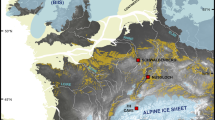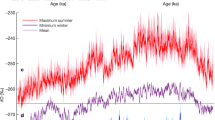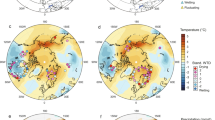Abstract
There has been concern about recent temperature trends and the future effects of CO2 concentrations in the atmosphere1,2; but instrumental records only cover a few decades to a few centuries and it is essential that proxy data sources, such as pollen spectra from peats and lake sediments, be carefully interpreted as climate records. Several workers have shown statistically significant associations between the modern pollen rain and climatic parameters, an approach that by-passes the recognition of pollen/vegetation units. Statistically defined equations that associate abiotic and biotic elements are called transfer functions. We report here on the application of transfer function equations to nine middle and late Holocene peat and lake sediment sequences from northern Canada (Fig. 1).
This is a preview of subscription content, access via your institution
Access options
Subscribe to this journal
Receive 51 print issues and online access
$199.00 per year
only $3.90 per issue
Buy this article
- Purchase on Springer Link
- Instant access to full article PDF
Prices may be subject to local taxes which are calculated during checkout
Similar content being viewed by others
References
Wigley, T. M. L., Jones, P. D. & Kelly, P. M. Nature 283, 17–21 (1980).
Manabe, S. & Stouffer, R. J. Nature 282, 491–493 (1979).
Webb, T. III & Bryson, R. A., Quat. Res. 2, 70–115 (1972).
Imbrie, J. & Kipp, N. G. in Late Cenozoic Ice Ages (ed. Turkeian, K. K.) 71–181. Yale University Press, 1971).
Kay, P. A. Quat. Res. 11, 125–140 (1979).
Andrews, J. T., Mode, W. N. & Davis, P. T. Arc. Alp. Res. 12, 41–64 (1980).
Howe, S. & Webb, T. III 5th Conf. Probability and Statistics 152–157 (American Metallur-gical Society, 1977).
Andrews, J. T. et al. Geol. Soc. Am. Abstr. 11, 379–380 (1979).
Andrews, J. T. & Nichols, H. (in preparation).
Mode, W. N. thesis, Univ. Colorado, Boulder (1980).
Davis, P. T. thesis, Univ. Colorado, Boulder (1980).
Nichols, H. INSTAAR Occ. Pap. No. 15 (University of Colorado, 1975).
Short, S. K. thesis, Univ. Colorado (1978).
Short, S. K. & Nichols, H. Arc. Alp. Res. 9, 265–290 (1977).
McAndrews, J. H. & Samson, G. Geogr. Phys. Quat. 31, 177–184 (1977).
Nichols, H. Eiszeitalter. Genenw. 18, 155–167 (1967).
Barry, R. G. et al. Arc. Alp. Res. 9, 193–210 (1977).
Keen, R. A. INSTAAR Occ. Pap. No. 34 (University of Colorado, 1980).
Short, S. K. & Andrews, J. T. Geogr. Phys. Quat. (in the press).
Stuckenrath, R., Miller, G. H. & Andrews, J. T. Arc. Alp. Res. 11, 109–120 (1979).
Author information
Authors and Affiliations
Rights and permissions
About this article
Cite this article
Andrews, J., Davis, P., Mode, W. et al. Relative departures in July temperatures in northern Canada for the past 6,000 yr. Nature 289, 164–167 (1981). https://doi.org/10.1038/289164a0
Received:
Accepted:
Issue Date:
DOI: https://doi.org/10.1038/289164a0
Comments
By submitting a comment you agree to abide by our Terms and Community Guidelines. If you find something abusive or that does not comply with our terms or guidelines please flag it as inappropriate.



